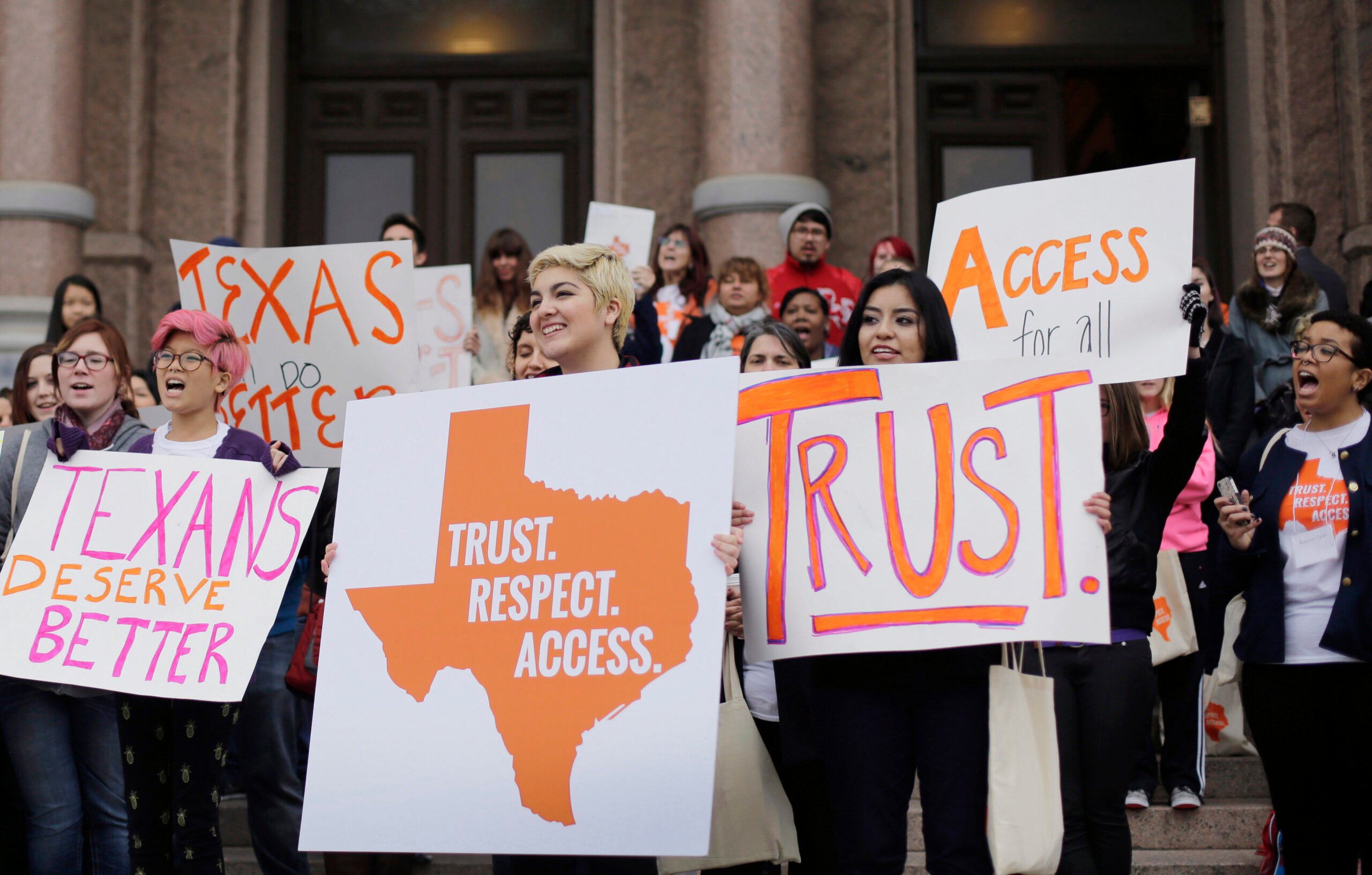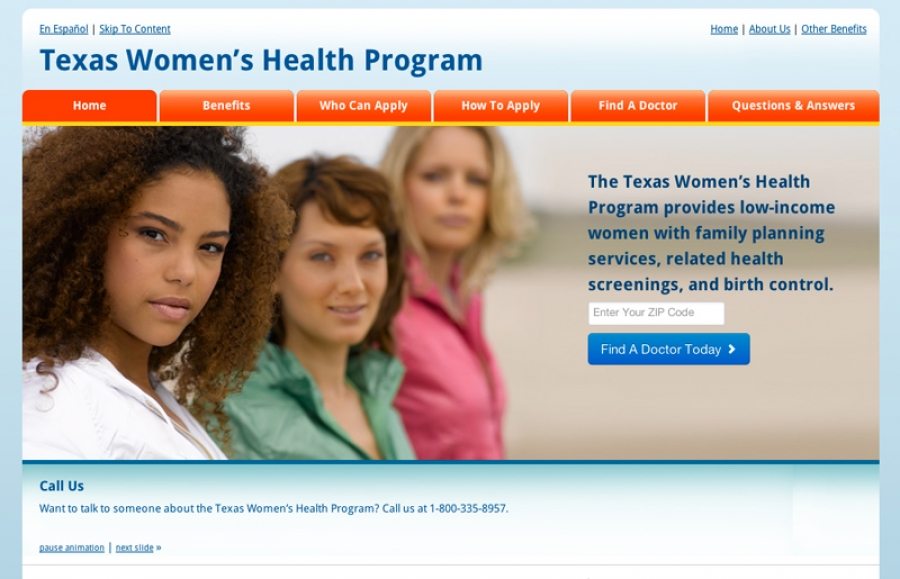
Pregnant? Scared? Can They Help?
The rise of crisis pregnancy centers and the abortion-alternative industry in Texas.
A version of this story ran in the December 2012 issue.
This is the fifth story in our Collateral Damage series examining the impact of family planning cuts in Texas. You can read the fourth story in the series here.
Meet Sadie, 13 years old and pregnant.
At least she thinks she’s pregnant, so, accompanied by her mother, she visits a place called Pregnancy Resources of Abilene. The center seems like a medical facility. It offers free pregnancy tests, on-site medical staff and, according to its website, a “warm and loving” team to guide Sadie through her options. The free test reveals what Sadie had suspected: She’s pregnant. A nurse gives Sadie a free ultrasound to confirm it. Then a counselor walks her through her options.
 Sadie has begun to seriously consider abortion. We know this because Pregnancy Resources of Abilene will later describe its treatment of Sadie in a report filed with the Texas Health and Human Services Commission. According to the report, counselors tell Sadie, whose name was changed in the report, that she has three options. “Now that you are pregnant, you are already a mommy,” counselors tell patients, according to the center’s website. Sadie could raise the child herself, and if she does it will be challenging but fulfilling. Or, she could choose adoption. This is “the most unselfish thing a mother could do for her child!” Then there’s abortion. Using a state health department booklet called A Woman’s Right To Know, counselors tell Sadie that during an abortion, her “unborn child” will be suctioned, scraped, removed piece by piece, or delivered dead. They tell the girl that women report “serious psychological effects” after abortion, including depression, flashbacks and thoughts of suicide. Counselors warn Sadie that her chances of infertility and breast cancer will increase, even though numerous studies have found no link between abortion and increased infertility or breast cancer. (The Texas Medical Association has deemed parts of the booklet “unnecessarily graphic” and “factually inaccurate.”)
Sadie has begun to seriously consider abortion. We know this because Pregnancy Resources of Abilene will later describe its treatment of Sadie in a report filed with the Texas Health and Human Services Commission. According to the report, counselors tell Sadie, whose name was changed in the report, that she has three options. “Now that you are pregnant, you are already a mommy,” counselors tell patients, according to the center’s website. Sadie could raise the child herself, and if she does it will be challenging but fulfilling. Or, she could choose adoption. This is “the most unselfish thing a mother could do for her child!” Then there’s abortion. Using a state health department booklet called A Woman’s Right To Know, counselors tell Sadie that during an abortion, her “unborn child” will be suctioned, scraped, removed piece by piece, or delivered dead. They tell the girl that women report “serious psychological effects” after abortion, including depression, flashbacks and thoughts of suicide. Counselors warn Sadie that her chances of infertility and breast cancer will increase, even though numerous studies have found no link between abortion and increased infertility or breast cancer. (The Texas Medical Association has deemed parts of the booklet “unnecessarily graphic” and “factually inaccurate.”)
What counselors might not tell Sadie is that she’s inside not a medical facility, but a crisis pregnancy center, the sole purpose of which is to persuade her not to have an abortion and, further, not to have sex until marriage. Crisis pregnancy centers are a creation of the anti-abortion movement, driven by a conservative religious ideology that hopes to convince women with unplanned or “crisis” pregnancies to choose childbirth over abortion. Though they may have the appearance of medical facilities, crisis pregnancy centers are not licensed to provide medical care. Some offer free sonograms—not for medical purposes, but to convince women to continue their pregnancies. They also offer free clothing, furniture, diapers and carseats, or “mommy dollars” with which to buy such items, in exchange for attendance at one of the center’s life-skills classes. Their religious affiliation is not always obvious. For example, even though the Pregnancy Resources of Abilene website tells clients, “We can help you find answers to your questions so you can make an informed decision,” it doesn’t tell clients that Pregnancy Resources of Abilene is a “Christian organization dedicated to promoting and defending the sanctity and integrity of all human life.” That information is stated on a separate website, for donors, that clients like Sadie don’t see.
With the help of Texas lawmakers, crisis pregnancy centers in the state are serving a growing number of women. Since 2005, the state health department, at the direction of the Texas Legislature, has given public money to centers to steer 72,000 women like Sadie to choose childbirth over abortion. (The state’s contract with the centers declares that counselors may discuss abortion only “in the context of promoting childbirth.”) The cash to bankroll the centers was diverted from the state family planning budget—money that had been used to provide Texas’ poorest women with birth control and wellness exams. The state is also directing women toward crisis pregnancy centers in other ways. A new law requires that abortion clinics provide patients with a list of crisis pregnancy centers at least 24 hours before an abortion can be performed. And callers to Texas’ state-funded 2-1-1 helpline seeking information about pre-abortion counseling will find crisis pregnancy centers included on the list.
Despite all the government support, the state doesn’t require such centers to promote medically accurate information about sexual health. Crisis pregnancy centers promote strict abstinence outside of marriage and don’t distribute birth control. And unlike family-planning clinics, they aren’t licensed or inspected by the state.
In 2011, Texas lawmakers cut funding for family-planning clinics by two-thirds and gave even more money to crisis pregnancy centers. Under a government initiative called The Texas Alternative to Abortion Program, state money now funds 50 crisis pregnancy centers, maternity homes and pro-life groups in Texas. Meanwhile, over the past two years, more than 60 Texas family-planning clinics have closed.
The effects are evident in smaller cities like Abilene, where crisis pregnancy centers are the only free option for pregnant women. Before last year, Sadie might have received testing and counseling at two state-funded family-planning clinics in Abilene. Unlike Pregnancy Resources of Abilene, these clinics imposed no morality on her decision and charged the state on average $70 less per patient—with no state funding applied to abortions. But after recent funding cuts, one clinic was forced to start charging clients and the other shut down.
In Sadie’s case, state lawmakers got what they paid for. After hearing her options, Sadie chose adoption. But what happened to her later is anyone’s guess. Despite having financed Sadie’s decision to choose adoption, the state health department took no further interest in her health. It didn’t ask the crisis pregnancy center to tell her about contraception and so lost the opportunity to protect her from sexually transmitted diseases or another unplanned pregnancy. Meanwhile, the state Medicaid program might have paid for her child’s birth and provided health insurance for her child.
Critics argue that the ideologically driven ethos of crisis pregnancy centers misleads women and could cause more unplanned pregnancies and more unwanted children, and, in the end, costs the state more money.
An Unhealthy State Investment
Texas’ investment in crisis pregnancy centers has climbed steadily since 2005. That’s when conservative Republicans convinced the Texas Senate Finance Committee to create the Texas Alternatives to Abortion Program, modeling it on a similar state-funded program in Pennsylvania. At each subsequent legislative session, more state funds flowed to the Texas Alternatives program; the program has received a cumulative $26.3 million in public money since 2005. The cash to pay for it comes directly from state budgets for family planning, health screenings and preventive care. Critics argue that this was a bad idea because cutting off family-planning providers reduces access to contraception, thereby increasing demand for abortions. But conservative lawmakers pushed ahead in the hope that they could force Planned Parenthood—the largest provider of pregnancy-prevention care in Texas—out of business, because a small portion of Planned Parenthood’s affiliates provide abortions. In line with federal and state law, Planned Parenthood never used public funds to provide abortions. Yet, in pursuit of a vendetta against Planned Parenthood, state lawmakers began siphoning money that once went toward pregnancy prevention into a program whose sole purpose is to promote childbirth.
The Texas Alternatives contract is administered by an organization called the Texas Pregnancy Care Network. Run by John McNamara, a business lawyer who describes himself on the network’s website as stepfather to two “crisis pregnancy” boys, the organization oversees 50 subcontractors. Each draws on state funds to provide counseling, clothing, food and furniture, temporary shelter, life-skills classes, and community referrals to women suffering “crisis” pregnancies.
The network is no stranger to criticism. NARAL Pro-Choice Texas found evidence of the network wasting funds, concluding in a stinging report that the Texas Alternatives to Abortion Program is a “tax-payer funded failure.” Investigations by the Austin Chronicle uncovered lax accounting practices and biased teaching materials. Similarly, the American Independent, an online news outlet, found widespread contract violations. Furthermore, the Austin City Council passed an ordinance requiring that crisis pregnancy centers in the city inform women that the centers aren’t medical facilities. The rule is currently unenforced while crisis pregnancy centers challenge it in court.
Yet despite many concerns, conservative lawmakers gave an additional $300,000 to the network in the last legislative session, removing cash from the family-planning budget that was shrunk by two-thirds. Texas crisis pregnancy centers now receive $4.15 million in taxpayer dollars each year.
What Happens To The Money?
The Texas Pregnancy Care Network didn’t respond to multiple interview requests for this story. But according to mandatory state filings obtained through an open records request, the network spends more than $3 million annually on client services, almost half a million dollars for outreach, and another $400,000 for administrative expenses. Unlike other state contractors, which are reimbursed only after they’ve delivered the service, the Texas Pregnancy Care Network gets cash up front and simply reports its monthly expenditures.
In the 2012 fiscal year, crisis pregnancy centers and other affiliates of the network saw 17,527 clients, according to filings. Most of the money went for “counsel” time—the one-on-one guidance provided to clients like Sadie—amounting to $2.5 million worth of advice.
The network spent $90,000 advertising the centers, $210,000 for its own site inspector salaries, and $105,000 to pay the executive director. The network paid $42,500 for consulting fees and “billing system rollout” fees to Real Alternatives in Pennsylvania, and it also spent $75,000 on the purchase and distribution of educational materials. A Texas Observer review of these materials shows that the state health department, which provides its literature for free, was the most-frequent source. Other educational materials came from four overtly Christian publishing houses.
The bottom line is that the network’s crisis pregnancy centers spent significantly more public money on each client than family planning clinics while delivering fewer services. Altogether, the Texas Pregnancy Care Network costs the state an average of $237 per client. By contrast, the average client at one of the family-planning clinics in Abilene—since defunded and disregarded by lawmakers—had cost $160.

Robbing Peter to Pay Paul
It’s striking that family-planning clinics could deliver a wider range of services, including pregnancy tests and other well-woman screens (STD and HIV tests, pap smears, breast exams) for an average of $77 less per client than the services that replaced them. That’s a stark discrepancy—even more so considering that the new beneficiaries of the state money don’t provide medical care, but simply “promote childbirth rather than abortion” according to the state’s contract.
Dr. Carla Ortique, a Houston obstetrician and a member of the Texas Medical Association, finds this troubling. “They are taking money away from family planning and giving it to centers that are dealing with the aftermath, with people who are already pregnant,” she said. “It just doesn’t make sense.”
Indeed, the state’s investment in abortion alternatives has gravely damaged family planning services. The Observer reported in August that more than 60 family planning clinics across Texas closed as a result of recent funding cuts, only 12 of which were operated by Planned Parenthood. The funding catastrophe intensified with the state’s efforts to take control of the Women’s Health Program, which had been part of Medicaid and paid for largely by the federal government. The program’s primary aim is to prevent unplanned pregnancies, but Texas Gov. Rick Perry and state Republican leaders have tried to remove Planned Parenthood from the program. That led the federal government to withdraw its funding. The state has promised to run its own version without Planned Parenthood. These decisions have damaged family planning clinics, and Abilene demonstrates how.
When legislators imposed massive cuts to family-planning budgets in 2011, the Abilene county health department was one of the big losers. Now it must charge women for services it used to provide free. Meanwhile, the other family planning player in town, Planned Parenthood of West Texas, lost $600,000 of funding. In November, its Abilene clinic closed, and 2,500 clients had to seek well-woman care, health screens and birth control elsewhere. Their options include the defunded county health department, small-scale private providers (who saw only 124 Women’s Health Program clients last year), and fee-charging clinics in other towns. At the same time, the local crisis pregnancy center was on the rise. Pregnancy Resources of Abilene got $60,997 from the state this year and, according to Internal Revenue Service filings, another $250,000 in private donations. The center ignored requests for an interview, but based on the Alternatives to Abortion Program’s average cost per client, the Abilene center probably used state funds to counsel approximately 250 clients. By contrast, Carla Holeva, director of Planned Parenthood of West Texas, estimates that the same money could have funded 381 women for well-woman exams, birth control and health care for a year.
Yet now that access to medical care has been reduced, other clients like Sadie, attracted by free tests, might flock to Pregnancy Resources of Abilene instead.
Birth Control Refuseniks
That decision will have an impact not just on Sadie’s immediate choices, but on her long-term health as well. Although the state doesn’t require crisis pregnancy centers to talk about contraception, many of them do. Sadie’s counselors, for example, will advise her that the only way to prevent another pregnancy is to abstain from having sex. Pregnancy Resources of Abilene advocates that women should only have sex “within the safety and security of marriage,” and that unwed clients who are already sexually active should simply stop. They won’t provide information about non-abstinence birth control because a central tenet of crisis pregnancy center ideology is that chastity is the only acceptable method of contraception for people who aren’t married. Some contractors to the Alternatives to Abortion Program even suggest that married women seek the counsel of both their doctor and their pastor if they wish to control their fertility.
Such faith in the power of chastity has strong political support at the Capitol. Known as the abstinence-only method, it’s a controversial approach to pregnancy prevention that is still taught in many schools. But critics have long questioned its effectiveness. The left-leaning nonprofit Texas Freedom Network reports that abstinence-only programs don’t change teen sexual behavior, so it’s no surprise that Texas has one of the highest teen-pregnancy rates in the U.S. Even public-health experts who embrace abstinence as the best way to prevent teen pregnancies are dismayed when it’s the only method taught.
Dr. Janet Realini, president of the Healthy Futures Alliance, a San Antonio-based coalition to prevent teen pregnancy, said that while abstinence is “a perfectly good choice for many people,” it is not a realistic choice for young adults who are already sexually active. Prevention is the key to reducing unplanned pregnancies and abortions, she said, noting that findings from the research-based Contraceptive Choice Project prove that accessible birth control reduces both pregnancy and abortion rates. Realini added that that she’s not aware of any studies showing programs effective in returning teens to abstinence or in keeping adults abstinent. Moreover, given that more than three-quarters of clients in the Alternatives to Abortion program are adults, and all are sexually active, she thought it irresponsible from a public-health perspective for crisis pregnancy centers to insist that abstinence is the only contraceptive choice. Is it likely that sexually active adults in their 20s and 30s will simply swear off sex until marriage?
The chastity message also infects counseling on sexual diseases. The state does reimburse crisis pregnancy centers for STD education, but according to an Observer review of educational materials, the Texas Pregnancy Care Network buys sexual-health literature only from pro-life publishers Life Cycle Books, Heritage House and the Medical Institute for Sexual Health. None of these publishers give clues, other than abstention, for how to prevent infection. The Medical Institute’s gonorrhea pamphlet, for example, advises readers: “Already had sex? Get checked out—and next time, get your facts straight.” The facts, as the Institute sees them, are that contraceptive methods like condoms are bad because they often fail. Dr. Thomas Schlenker, director of public health for the San Antonio metropolitan health district, found this message “disturbing and dishonest.” He said: “It is standard and well founded and universally accepted that condoms are an effective way to prevent STDs as well as pregnancy.”
Dr. Ortique was also concerned. “It is my understanding that crisis pregnancy centers are unregulated and are giving medical advice to women who are either young and/or economically or socially unstable at a time when they are the most vulnerable. Women in this condition must receive factual, unbiased information regarding their medical condition.”
What Lies Ahead?
As evidence-based providers go out of business for lack of funding, ideology-based providers are ready to replace them. The Source for Women, a crisis pregnancy center in Houston, for example, became a certified medical clinic this summer and was hailed by Gov. Perry as the new life-affirming face of the Women’s Health Program. The Source will use state funds to provide anti-abortion counseling in Blessing Rooms, as well as well-woman exams, STD testing, breast exams, and sonograms in suites labeled Window To The Womb. When asked about contraception, Tiffany Pardue, The Source’s media coordinator, said by email that The Source will comply with the standards of the Texas Women’s Health Program (which provides comprehensive birth control) but that, because of antibiotic resistance and condom failure rates, will take a “risk avoidance” approach to STD prevention.
The practice of state-sponsored providers promoting medically inaccurate information is worrisome, especially when clinics offering medically accurate information services are forced to close. Yet arguing for comprehensive science-based services is impossible, Dr. Ortique notes, adding, “if you can’t convince someone that 1+1 = 2, then you will not be able to convince them of anything.”
Unless the political mood shifts in the next legislative session, Texas’ bond with the abortion-alternatives industry will continue. They won’t have to tell women that there are other options besides chastity. They will continue to get money, not only from family-planning funds, but also from the sale of Texas license plates exhorting drivers to “Choose Life.” Indeed, without a sharp change in policy from the Legislature, the state will continue to bankroll a program that misleads vulnerable women about the most important choice they might ever make.
A quote from the nurse manager at Pregnancy Resources of Abilene, Cindy Ward, on the center’s website captures this new world: “Our ministry is growing and continues to be blessed by the Lord. We are seeing more unchurched, abortion minded women than ever before. We continue to pray that the Lord will bless our clinic and reach out to our community to embrace life!”
As the state of Texas enthusiastically funds this alternative service network, Nurse Ward may continue to feel blessed. Wherever else her prayers may be heard, they’re surely being answered inside the Texas Capitol.


